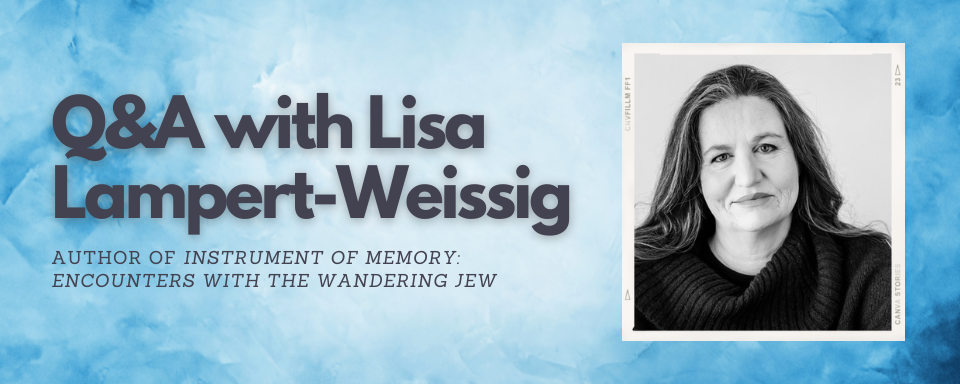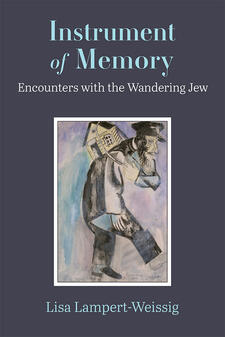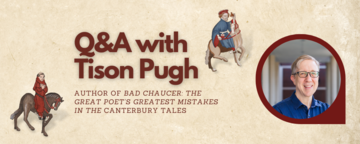Q&A with Lisa Lampert-Weissig
Author of Instrument of Memory

This guest author post is a Q&A with Lisa Lampert-Weissig, author of the new book Instrument of Memory: Encounters with the Wandering Jew, from the University of Michigan Press. The book is available in hardcover and open access.
For readers who may be unfamiliar, could you please give a brief summary of the legend of the wandering Jew?
According to the legend, which has been circulating since at least the sixth century, as Jesus bore the cross on the way to crucifixion, he stopped in front of a Jewish man’s home and asked if he could rest there for a moment. The man harshly refused, instead taunting Jesus to hurry to his death. In response, Jesus cursed the man to wait until Jesus’s return. The man’s experience caused him to convert to Christianity and he is said to roam the earth, telling all he meets of his encounter with Jesus. The details of the legend, such as the Wandering Jew’s age, abilities, and demeanor vary across the many hundreds of representations in literature, visual arts and music. One factor, however, endures across most versions: the Wandering Jew’s immortality is a curse. He is haunted by loss and by his memories. My project traces this persistent element of memory across the centuries of the Wandering Jew tradition.
How has this legend been adapted or reimagined between the medieval or early modern times and today?
The two most influential early written versions of the legend, found in Matthew Paris’s thirteenth-century Chronica majora and in the popular 1602 pamphlet Kurtze Beschreibung und Erzehlung von einem Juden mit namen Ahasverus (A Brief Description and Narration Regarding a Jew Named Ahasuerus) focus on the Wandering Jew as a witness of Christian history, almost like a kind of living relic. A major shift in how the Wandering Jew was portrayed came in the late eighteenth-century, heralded by Christian Friedrich Daniel Schubart’s 1783 poem “Der Ewige Jude: eine lyrische Rhapsodie” (The Eternal Jew: A Lyrical Rhapsody). Schubart endows the Wandering Jew with interiority and humanity, focusing on the figure’s grief over his personal losses and struggles. More such portrayals followed, including those by major Romantic figures like Percy Bysshe Shelley. At the same time, however, that these re-imaginings of the Christian tradition of the legend elaborate on the Wandering Jew’s character—humanizing him as it were—they also de-emphasize his Jewishness, as if humanity and Jewishness were somehow incompatible. Around the same time as this shift in depiction we also begin to see the legend taken up by writers of Jewish descent, most notably by Heinrich Heine, whose work is featured in my book. In his last work, Romanzero, Heine uses Jewish memory traditions to imagine an encounter between the Wandering Jew and Yehuda Halevi, one of the most influential poets of the medieval Jewish tradition. I see Heine’s beautiful, poignant representation as the start of a powerful modern Jewish tradition of the legend.
Antisemitism is unfortunately a problem that still persists in the modern day — how does this medieval legend reflect current Jewish - Christian relationships?
When contrasted with other medieval Christian myths about the Jews, such as ritual murder accusation, blood libel, and other associated conspiracy theories that continue to circulate today, the Wandering Jew legend can seem relatively benign. The Wandering Jew of Christian legend, however, embodies the enduring concept of supersession. Supersession is the notion that Christianity supersedes Judaism because Christianity is the true and rightful fulfillment of Jewish prophecy. In Christian versions of the legend, the Wandering Jew’s experience with Jesus, conversion, and subsequent existence serve as signs of Christian truth. The supersessionist perspective frames Jewish experience and even Jewish individuals as instruments of Christian teachings, or, as I argue about the case of the Wandering Jew, as instruments of Christian memory. This perspective denies Jewish agency and even Jewish humanity by framing Judaism, Jewish belief and even Jews themselves as existing to serve Christian needs. This is starkly framed by the medieval monk, Matthew Paris, who views the Wandering Jew as a “proof of the Christian faith.” It is represented in Eugène Sue’s secularized depiction of the Wandering Jew in his 1844 novel Le Juif errant (The Wandering Jew), in which not only the Wandering Jew (and Jewess), but also ancillary Jewish characters all exist to serve a Protestant family. While not equivalent to antisemitism, Christian supersessionism plays a role in antisemitic thought and in what historian Magda Teter has recently referenced as “Christian supremacy.” The Christian tradition of the Wandering Jew legend and Jewish-resistant adaptations of it reveal the role of supersessionism in Jewish-Christian relations and in antisemitic discourses.
What surprised you the most when conducting research for this book?
I didn’t realize at first that I was going to trace the legend into the present day, but it became clear that this was essential to understanding it in a way that included Jewish voices. Yet I didn’t want to imitate the encyclopedic approach of earlier studies. I decided to focus on some of the most influential representations of the legend and to study them in-depth, using a method I now think of as “deep-dive diachronic.” This involved trying to situate each text within its historical context as well as within the author or artist’s larger body of work, including critical reception. I was surprised by how much fun this was. The pandemic opened up online access to many primary documents that I wouldn’t otherwise have been able to work with readily unless I traveled. Thanks to the efforts of many talented and dedicated librarians, I was able to time travel while we were all stuck at home. I certainly couldn’t have foreseen this adventure when I became interested in the Wandering Jew legend many years ago.
What do you hope readers will take away from Instrument of Memory?
I am struck by how much representations of the Wandering Jew are about moments of encounter. I hope that readers will get a sense of the intensity of the artistic encounters that creators like Heinrich Heine, Marc Chagall, and Stefan Heym have had with the Wandering Jew. For artists of Jewish descent especially, I think the legend evokes not only cultural memory, but powerful emotion. The Jewish artists who work with the Wandering Jew figure appropriate and remake the medieval Christian legend in ways that don’t simply speak back to it, but that use it to enrich Jewish tradition and Jewish cultural memory. There is a beautiful tension between the individual and the collective in these works. I hope my readers get to share in that and that they are inspired to seek out the original works discussed in Instrument of Memory if they don’t already know them.



